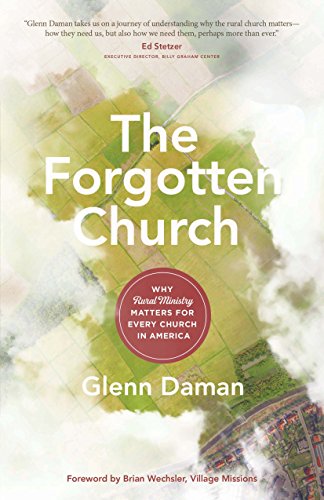Book Review: The Forgotten Church, by Glenn Daman
March 28, 2019

March 28, 2019
Glenn Daman, The Forgotten Church: Why Rural Ministry Matters for Every Church in America. Moody Publishers, 2018. 258 pages.
“Why on earth would you want to plant a church in rural North Carolina?” I was asked this question ad nauseam prior to planting Redeemer Church. “You need to be in the city.” Despite my protest that small towns and rural communities were important fields of ministry, I had few resources to validate my position. Then, along came Glenn Daman’s The Forgotten Church—a book I wish had been written ten years sooner. The Forgotten Church is a compelling and thoughtful presentation of the value of small community ministry and the of the need for healthy local churches in those communities.
In The Forgotten Church, Daman recounts the history of rural life and ministry in the United States—a survey that pastors and church planters will find particularly instructive. Daman notes that as early as 1908, rural communities were in steep moral decline (73). Even at the dawn of the twentieth century, the lack of gospel influence in these small towns led to emerging social problems. This bleak portrait of rural communities remains true today. For example, small towns are hotbeds for the opioid epidemic. Without churches leading the way in Christ-centered approaches to drug rehabilitation, many communities are forced to send addicts (if they do anything at all) to rehab centers, divorced from the gospel, in the nearest city center.
Daman demonstrates that rural communities have been forgotten and left behind by both society and by church planters and pastors. Seminary curriculum generally focuses on preparing pastors to minister in city centers rather than small towns (73). This fact certainly rings true in my personal experience. As a seminary student, nearly every ministry practice advocated by the faculty presupposed the presence of a major city center.
This obsession with ministry in the city is certainly odd when we remember just how many churches are located outside of major metropolitan areas. In fact, the majority of churches in the two largest Protestant denominations in the United States, the Southern Baptist Convention and the United Methodist Church, are primarily located in small or rural towns. If we don’t share any interest in the spiritual well-being of rural communities, we are in fact ignoring most of the churches in our nation. The Forgotten Church reminds us that we must not neglect the rural mission field.
Over the last decade, a number of authors have rightly advocated that churches ought to engage in “mercy ministry”—ministries that commend and adorn the gospel. Most people assume that only cities need this type of gospel-illustrating, hands-and-feet ministry. Daman’s research, however, shows that rural America’s battle with poverty is severe and that these under-resourced communities are stuck in a cycle of poverty (96).
The micropolitan community where I pastor has suffered with poverty and a lack of resources for generations. Further, few churches have been able to extend gospel-centered mercy in a way that meaningfully impacts the community. Small towns are crying out for mercy ministry.
Additionally, small towns are hotbeds of racial division. As Christians have increasingly become aware of the need for racial reconciliation as a work of the gospel in society, many people assume that the most severe instances of racial division are always found in major city centers. Yet, rural communities are often racially diverse and racially segregated (113). In many rural communities, fear and skepticism abound when any efforts toward racial reconciliation begin. Rural communities need local churches that understand how the gospel produces racial reconciliation.
One of the ways forward, according to Daman, is to forge strategic partnerships between theological and ministry training institutions and small town ministries (196). Our church has taken many of the steps proposed by Daman and has produced much fruit in raising up leaders and adding them to our church’s staff or in sending them out to serve other churches. Additionally, our church has partnered with a “Small Town Jesus” cohort based in North Carolina. This cohort is composed of pastors and church planters in rural communities who are working together to develop strategies for reaching rural America. In short, our church can attest to the truthfulness of what is proposed in The Forgotten Church—strategy and partnerships are critical for engaging rural communities.
The Forgotten Church does not portray ministry in small towns or rural communities as glamorous; it isn’t. The strength of Daman’s work is its honesty. Choosing to minister in a rural community is a choice likely to minister in obscurity in a place that many in society (Christian or otherwise) assert does not matter. Perhaps modern evangelical intuitions about small communities are bit too Nathaniel-like, “Can anything good come out of Nazareth?” In the words of Phillip, I’m sure Daman would say, “Come and see.” (Jn. 1:46).